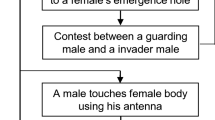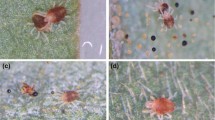Summary
Male wasps of three sympatric species of Nearctic Megarhyssa (Hymenoptera: Ichneumonidae) typically form mixed-species (61.7%) aggregations composed of up to 28 males over sites of female emergence. Observations of 107 aggregations over two seasons in New York state revealed two male mating strategies: postemergence copulation on the tree surface and preemergence insemination accomplished by male abdominal insertion into the female emergence hole. Insertions by one or more males (as many as ten consecutively but not more than two simultaneously) occurred at 88% of the aggregations, with each inserting for an average of 24.8 min. Insemination as a result of preemergence insertion had a success rate of 83% while postemergence copulation attempts were successful 30% of the time (average duration 61.9 s). Individual male reproductive success was very low and not correlated with size, arrival order at emergence sites, or tenacity at the site. Males frequently aggregated at sites of male emergences as well as those of nonconspecifics, though conspecifics to the emerger ultimately played the major role at aggregations. Male-male aggression in aggregations was not apparent, though jostling occurred during the insertion period and during postemergence copulation attempts.
Similar content being viewed by others
References
Alcock J, Barrows EM, Gordh G, Hubbard LJ, Kirkendall L, Pyle DW, Ponder TL, Zalom FG (1978) The ecology and evolution of male reproductive behaviour in the bees and wasps. Zool J Linn Soc 64:293–326
Champlain AB (1921) The curious mating habit of Megarhyssa atrata (Fab.) (Hymen.: Ichneumonoidea). Entomol News 32:241
Dawkins R (1980) Good strategy or evolutionarily stable strategy? In: Barlow GW, Silverberg J (eds) Sociobiology: Beyond Nature/Nurture? Westview Press. Boulder, CO, pp 331–367
Emlen ST, Oring CW (1977) Ecology, sexual selection and the evolution of mating systems. Science 198:215–223
Gade G (1834) Bull Brooklyn Entomol Soc 7:103–104
Gibbons JRH (1979) A model for sympatric speciation in Megarhyssa (Hymenoptera: Ichneumonidae): competitive speciation. Am Nat 114:719–741
Harrington WH (1882) Long-stings. Can Entomol 14:81–84
harrington WH (1887) The nuptials of Thalessa. Can Entomol 19:206–209
Heatwole H, Davis DM, Wenner AM (1963) The behavior of Megarhyssa, a genus of parasitic hymenopterans (Ichneumonidae: Ephialtinae). Z Tierpsychol 19:652–664
Heatwole H, Davis DM, Wenner AM (1964) Detection of mates and hosts by parasitic insects of the genus Megarhyssa (Hymenoptera: Ichneumonidae). Am Midl Nat 71:374–381
Heatwole H, Davis DM (1965) Ecology of three sympatric species of parasitic insects of the genus Megarhyssa (Hymenoptera: Ichneumonidae). Ecology 46:140–150
Lintner JA (1883) The black long sting. Country Gentleman 48:561
Matthews RW (1975) Courtship in parasitic wasps. In: Price PW (ed) Evolutionary strategies of parasitic insects and mites. Plenum Press, New York, pp 66–86
Matthews RW, Matthews JR, Crankshaw OS (1979) Aggregation in male parasitic wasps of the genus Megarhyssa: I: Sexual discrimination, tergal stroking behavior, and description of associated anal structures behavior. Fl Entomol 62:3–8
Nuttall MJ (1973) Pre-emergence fertilisation of Megarhyssa nortoni nortoni (Hymenoptera: Ichneumonidae). NZ Entomol 5:112–117
Parker GA (1978) Sexual selection and sexual conflict. In: Blum MS, Blum NA (eds) Sexual selection and reproductive competition in insects. Academic Press, New York, pp 123–166
Stillwell MA (1967) The pigeon tremex, Tremex columba (Hymenoptera: Siricidae), in New Brunswick. Can Entomol 99:685–689
Thornhill R (1976) Sexual selection and paternal investment in insects. Am Nat 110:153–163
Townes HK, Townes M, (1960) Ichneumon-flies of American north of Mexico: 2. Subfamilies Ephialtinae, Xoridinae, Acaenitinae. US Natl Mus Bull 216 (part 2)
Author information
Authors and Affiliations
Rights and permissions
About this article
Cite this article
Crankshaw, O.S., Matthews, R.W. Sexual behavior among parasitic Megarhyssa wasps (Hymenoptera: Ichneumonidae). Behav Ecol Sociobiol 9, 1–7 (1981). https://doi.org/10.1007/BF00299846
Received:
Accepted:
Issue Date:
DOI: https://doi.org/10.1007/BF00299846




